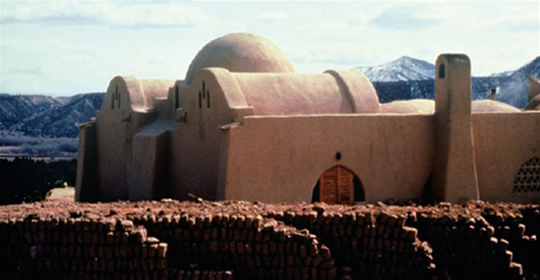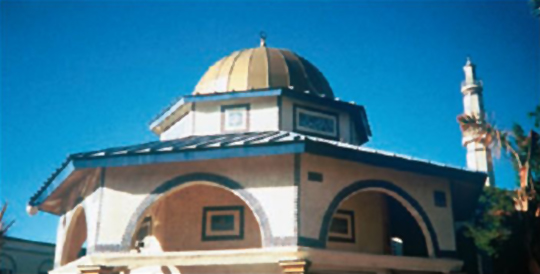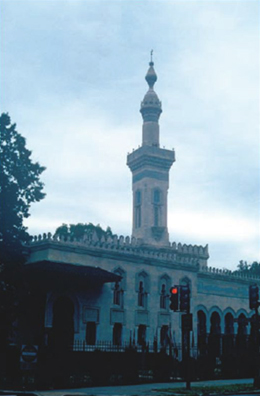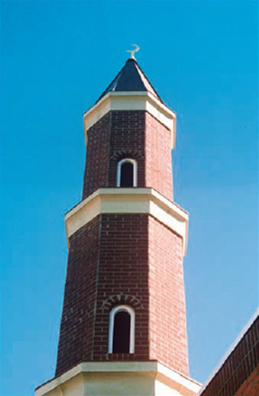Imported Design
4There are mosques that embody a traditional design transplanted entirely from Islamic lands. Examples are the Islamic Cultural Center in Washington, D.C. (built in 1957); the Islamic Cultural Center in Tempe, Arizona (1984), and the Islamic Center of Virginia in Richmond, Virginia (1990). 5The Islamic Center of Washington, D.C. was the first of the large, traditionally designed structures, and architecturally it is still one of the most significant buildings that Muslims have built in the United States. It is listed, and thus protected, as a historical American building. It was designed by Mario Rossi, an Italian architect practicing in Cairo, with the help of engineers from the Egyptian Ministry of Pious Foundations, whose functions include care of mosques supported by religious endowments. 6The transplanted-mosque approach has been used by Muslim and non-Muslim architects alike. For most of them, stylistic imitation meant “capturing the flavor” of the old, the familiar—or, at most, “blending” old and new. This nostalgic community of Muslims was of a generation that, in the words of non-Muslim architect William Preston, sought “the stability and humanness embodied in vernacular and premodern architectures.” 7The role of the architect is to bring back the past, the familiar; to make the users of the building feel at home; and to reinterpret its vocabulary in everyday language that can be easily understood.Adapted Design
8Other mosques represent a reinterpretation of tradition, sometimes combined with elements of American architecture. Examples are the Islamic Cultural Center in New York City (1991) and Daral-Islam in Abiquiu, New Mexico (1981). 9Mosques that have attempted a reinterpretation of traditional architecture in the American landscape have had mixed results. The Islamic Cultural Center (ICC) of Manhattan is one example. It was designed by the prestigious firm of Skidmore, Owings & Merrill and completed in 1991 on a site in uptown Manhattan at the intersection of Third Avenue and 96th Street. The project represents an effort to find an image that would please both the Muslim community and the larger, surrounding society. The mosque was designed for the use of Muslims in the New York City metropolitan area, who include high-profile, influential Muslim diplomats and others attached to the United Nations, consulates, and trade offices. During the design stage of the project, the ICC board appointed two advisory committees, one composed of “prominent members” of the Muslim community in New York, the other of architects, mostly non-Muslims. The debate between the two groups centered on the image of the mosque. The architects wanted a “mosque that belonged to the 21st century.” The Muslims wanted the designers to reproduce the style of a traditional mosque with literal versions of historic motifs. 10After a long and thoughtful debate the two committees agreed on a “modernist” building, but with the Muslim committee insisting on the inclusion of both a minaret and a dome, neither of which were favored by the architects’ committee. The conflicting perceptions of what a mosque ought to look like brought into high relief the salience for many Muslims of “old and familiar,” a preference that many Westerners are unaware of and some Muslims prefer to disregard. 11Similar to the Washington, D.C., mosque in conceptual framework, but differing in scale and location, is the Dar al-Islam mosque in Abiquiu, New Mexico, designed by the great Egyptian architect Hassan Fathy. It was built in 1981 and is used predominantly by native-born American Muslims. The mosque’s dramatic form, as sculptural as anything in the surrounding landscape, was achieved by combining a Byzantine and Sasanid dome, barrel vaults, and large, pointed arches. The Dar al-Islam mosque grew out of the same romanticized regional style that Fathy created for New Gourna in Egypt, and uses the same earthen construction. Because of New Mexico’s cultural links to Spain, which nurtured a local mud-brick building tradition quite similar to that in New Gourna, Fathy’s Dar al-Islam is certainly appropriate to its context.Innovative Design
12There are the designs that are entirely innovative, like those of the Islamic Society of North America’s headquarters in Plainfield, Indiana (1979); the Islamic Center of Albuquerque, New Mexico (1981); the Islamic Center of Edmond, Oklahoma (1992) and the Islamic Center of Evansville, Indiana (1992). 13A decisive departure from both the transplanting of traditional architecture and the modern reinterpretation of it can be found in the designs of Gulzar Haidar, a Pakistani-Canadian, and Bart Prince, an American. Their projects represent the innovative, the creative and the unprecedented mosque. Haidar advocates a design approach that is “environmental,” “morphological” and “semiotic.” His notable example is the mosque in the Islamic Society of North America (ISNA) headquarters in Plainfield, Indiana. According to Haidar, Islamic architecture should be expressive and understandable to all. It should employ a form of language that invokes in immigrant Muslims a sense of belonging in their present and hope in their future. To the indigenous Muslims it should represent a linkage with Muslims from other parts of the world and should underscore the universality and unity of Islam. To the new Muslim this architecture should invoke confidence in their new belief. For non-Muslims it should take the form of clearly identifiable buildings which are inviting and open, or at least not secretive, closed, or forbidding. 14The ISNA mosque has an austere contemporary character that is entirely without iconic references to traditional Islamic architecture. The solid exterior walls give few clues about what is inside. According to Haidar, the ISNA mosque addresses itself to Muslims through its concepts of albatin (“the hidden”) and al-zahir (“the manifest”), two of the 99 beautiful names of God, through mystical geometry, and particularly through its cubical form, a subliminal reminder of the Ka’ba, the symbol of unity. He relates his decision to contrast the inside and the outside to the fact that Muslims are a minority living in predominantly non-Islamic America. He sees this contrast as symbolic of the fact that Islam in this country is a private matter of faith, rather than the state religion that it is in much of the Islamic world. 15Conceptually related to the ISNA headquarters in terms of innovative mosque design are a number of other Islamic centers. One was the Islamic Center of Albuquerque, New Mexico, completed in 1991, which was demolished in 2005 and is currently replaced by a new building. The former Islamic Center was designed by Bart Prince, a leading exponent of organic architecture. From a distance, the building resembled a giant set of bleachers reaching skyward in tiers and topped by towers that contained tall, narrow windows. Inside, the mosque was essentially one large hall divided at prayer times by a temporary partition to separate men from women. The ceiling stepped up with the tiers, supported by thick wooden beams and rafters made of bronze-colored pipe. Daylight poured through the narrow windows. It was a simple, elegant building, functional, and completely at home in its environment. 16The work of the New Mexican architect resists easy translation into words. Dramatic and often unusual forms characterize this project, like his other buildings in New Mexico. His style is rooted in the peculiarly American tradition of organicism. Defined by Frank Lloyd Wright and the Oklahoman architect Bruce Goff, the organic tradition argues for the necessary individuality of each architect and each architectural design. The tradition’s individualism makes it difficult to attribute a coherent set of stylistic characteristics to it. Coherence comes instead from a shared attempt to create an organically integral architecture that rethinks the possibilities of geometry, space, structure, and material.Mosque Design in North America
17What do these various mosque projects tell us about the nature and direction of mosque design in North America? New and culturally uncertain Muslim communities at first often constructed mosques that were architecturally nondescript. Better established communities have built a large number of mosques in the purely traditional styles found in their Muslim homelands, with little regard to their surroundings in North America. Some architects have experimented with reinterpreting traditional styles, using mixed designs and achieving equally mixed results. The innovative mosques of Haidar, Prince, and Karim have not always been well received by the immigrant Muslim communities because they do not match the immigrants’ notions of what a mosque should be. Given the extreme diversity of America’s Muslim population, it would seem logical to favor the unprecedented mosque, with maximum regard for the strictly Islamic requirements and minimum regard to ethnic or national taste or historical style, be that Ottoman, Mamluk, or Mughal. We have seen such a compromise reached in the case of the minaret of the ICC mosque. 18Attachment to traditional design principles is, however, by and large restricted to first-generation immigrant Muslims. Their descendants and American converts to Islam, who will eventually constitute the majority of the U.S. Muslim population, will probably tip the scales in favor of more innovative architecture. Many Muslims of all backgrounds may even see this as responding to a prime Islamic imperative: to live in harmony with the total natural and historical environment of a place.Adapted from the article “Mosque Design in the United States” by Omar Khalidi, Saudi Aramco World, (November/December 2001): 24–33 .
Built 1984 by M. Afzal Ibrahim.
 Islamic Center Village, Abiquiu, New Mexico.
Islamic Center Village, Abiquiu, New Mexico.Built 1981 by Hassan Fathy, a renowned architect from Egypt.
Author
Suggested Citation

This work is licensed under a Creative Commons Attribution-ShareAlike 3.0 Unported License.





